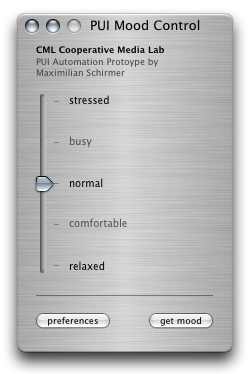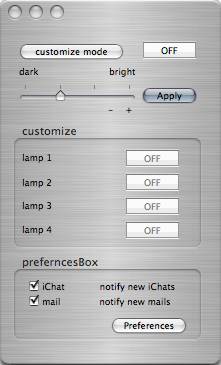|
|
LP_PhysicalUserInterfacesPhysical User Interfaces: Scenarios and Prototyping - Summer Term 2005DescriptionPhysical user interfaces offer users new means of interaction with their computer usually beyond keyboard and mouse. This lab project covers techniques to design systems using scenarios (textual or graphical descriptions). The project focused on developing of prototypes to implement simple scenarios (e.g. cooperative rooms, the remote administration of buildings, or room observation). The project mainly based on the SensBase infrastructure, we developed in the winter term 04/05. The main result of this project is an AppleScript? library for Mac OS X 10.4, which contains mainly "software sensors". The software sensors are applications which gather information about the users and the systems (e.g., current user’s activity, running operating system processes). The library contains many software sensors (e.g., DVD Player sensor to gather the current state of the DVD Player application, or the iCal sensor to gather information about the events and issues pending stored in the iCal calendar.). The sensors are managed by the Sensor Data Collector (cf. Figure 1), which collects and puffers the sensor’s data and concludes the communication with the SensBase infrastructure. Figure 1. The Sensor Data Collector. Three scenarios were developed and implemented in this project: Mood Control, Moodoxic, and gimmeLight. Mood ControlThe Mood Control (cf. Figure 2) enables users to experience a set of themes that suit to their current stress level or mood. These themes (e.g. cleaning the desktop, muting iChat conversations by sending automated messages, or changing the desktop picture) will give users the chance to calm down and have some quiet minutes if they are in the middle of a very high stress level phase. On the other hand, if they are already very calm but their calendars have some pending activities waiting for them, Mood Control will encourage them to finish open tasks. Figure 2. Mood Control Application. MoodoxicThe aim of this scenario is to provide a visualization of a team’s mood using LEDs. The Moodoxic application (cf. Figure 3) determines the mood of team members by collecting and analyzing of gathered by software sensors about the team members and visualizes the mood of a team as well as of individual users using LEDs. Figure 3. Moodoxic Application. gimmeLightThis scenario shows the possibility of automatically controlling of the light inside a room (e.g. by watching a movie, reading, etc.). The gimmeLight application (cf. Figure 4) collects and analyzes data gathered by software sensors about each individual user to set up the light brightness around the users depending of their current activities. Figure 4. gimmeLight Application. Current StatusFinished.Past Events
ResourcesPeopleTom Gross (Supervisor)Tareg Egla (Supervisor) Christoph Beckmann Stefan Dietzel Maximilian Schirmer Created by: oemig last modification: Tuesday 30 of August, 2005 [13:12:40 UTC] by egla |

